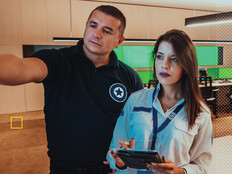NComputing X550
Desktop Virtualization Takes Off
Microsoft Desktop Optimization Pack 2009
NComputing X550
With today's powerful and inexpensive PCs, much computing horsepower is wasted. The NComputing X550 desktop virtualization kit allows up to six users to share the same PC, maximizing efficiency while maintaining independent user sessions.
End-User Advantages
For the end user, it's really hard to tell that there's not a PC under the desk. Each user gets a discrete workspace. Applications, files, settings and preferences are stored independently, giving each user an individualized, rich experience. Instead of being connected to the PC, the keyboard, mouse and monitor are connected to a small, 4.5-by-3.5-inch device that can be mounted to the back of a monitor. How's that for quiet, not to mention green?
In the past, such solutions struggled in terms of audio and video performance, but not the X550. Full stereo output is supported via a standard (3.5 millimeter) speaker port. The X550 also supports resolutions of up to 1280x1024 (standard) and 1440x900 (widescreen) pixels at 16-bit color, with a 60 hertz refresh rate -- which is to say, it's likely to support anything that you do now. Even full-screen, full-motion video works fine.
Why It Works for IT
The NComputing product includes one X550 PCI card, five XD2 access devices and vSpace desktop virtualization software. You simply supply the PS/2 keyboards and mice, the monitors, and standard CAT 5e or CAT 6 cables to connect the X550 in the host computer with the five XD2 access devices.
The vendor provides 10 mounting screws for attaching the XD2 devices to the back of monitors. With support for both Microsoft Windows and Linux operating systems, installation of the PCI card and software is a snap. If you like, you can install a second X550 PCI card to support up to 11 users.
No special training or modification of your applications are necessary. The vSpace software takes care of the multisessions, and each user's preferences and settings are stored in their own user directories on the PC.
External power supplies aren't necessary either, as each XD2 device draws only about one watt of power directly across the cable from the host PC. The X550 system also supports power-saving mode with Energy Star–compliant monitors. Is this the ultimate in eco-friendly solutions, or what?
In addition, you reap some of the benefits of a virtual desktop infrastructure. Instead of managing and securing six or 11 PCs, you have to manage only one. Suddenly, your 100-PC problem becomes a more manageable 10-PC problem.
Disadvantages
As you might expect with sharing a single PC, the X550 isn't for every application. It's not recommended for heavy 3D-intensive applications such as computer assisted design (CAD) or movie editing software. Power users may notice a slowdown if they're sharing a PC with others who also do heavy number crunching or other processor-intensive tasks. But for most knowledge workers, sharing shouldn't be a problem. If it is, try scaling back a little; even three users sharing a personal computer is a benefit.
Also note that the XD2 devices have PS/2 connections, not USB. Thus, the keyboard and mice need to be either PS/2 compatible or have adapters. For users who require USB for other external devices, the vSpace desktop virtualization software can assign USB ports to different users. You need to supply the USB extension cable to get from the host PC to the device.
Users also have to sit relatively close to one another. Even using standard CAT 6 shielded twisted-pair cable, the range is only 33 feet. CAT 5e cable is less than half that, at 16 feet. Hence, the NComputing X550 solution is best used in office cubicle environments or for student workstations. Then again, these are probably also the people who use applications most suited to this solution anyway.








